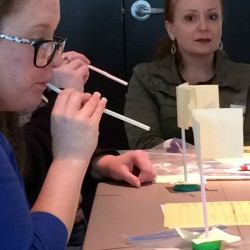 View larger
View larger
Wind Turbine Tech Challenge
New activity
Participants consider what they know about how wind turbines work and how wind energy could be used to provide electricity to a community park.
Open Activity
How-to Video
Implementation Guide
Provides extensive background information, facilitation outline, materials shopping list, extended supporting media suggestions, correlations to national standards, and more.
Teacher's Guide
Provides classroom connections, key concepts, connections to science standards, and additional resources.
Family Take-home Activity
A take-home that can be sent with patrons that wish to do STEM activities at home. These at-home activities cover similar topic areas as the associated activity and could be handed out at the conclusion of a program or left on a circulation desk for patrons to take home.
-
Rating
-
Participants Enjoyed the ActivityParticipants Learned from This ActivityActivity Instructions Were Clear and Easy to FollowWould Recommend
Related Programming Resources
Reviews
Some caveats, but lots of potential (energy?)
All that is gold does not glitter, but that’s what glitter glue was invented for! We used great big dollops of the stuff in our wind turbine projects during a recent Monday Makerspace event! While running this activity in our library, we discovered quite a few truths about life in general and wind turbines in particular, including:
- It is always a good plan to bring models and props, and not just for the younger kids; *all* of our participants were eager to craft individual designs that were as different as possible from each other, and it became something of a one-upmanship situation. Providing pictures of various wind turbines out there in the world gave them ideas for modifications to sail/blade shape, straw/tower orientation, and more.
- Depending on the setup, modeling the various steps required to build the basic turbine may prove necessary, as it did for us. We ended up building several demonstration turbines over the course of our two-hours-long Makerspace, as groups of kids were coming in and going out the whole time.
- Shiny paper for blades, glitter glue for “decoration,” and various colors of sticky notes are all vital ingredients if you want to capture young participants’ interest for more than five minutes. We made the mistake of expecting that once kids had built a basic turbine they’d stick around to glam them up, but it turns out they only exhibited that sustained interest if they were able to lay hands on the shiny bits right away. Once they’d finished one turbine, they were world-weary and ready to move on to other Makerspace activities.
- This was a more difficult activity than some to “sell” the kids on than others we’ve hosted recently. That is, many children and even some of the young teens were not immediately and enthusiastically immersed in the activity for its own sake. We bribed them with giveaways and prizes for those who completed working turbines, and that proved inducement enough for some, but others were frustrated with the difficulty of the project. It requires fine motor skills and an openness to spend time troubleshooting, and it lacks the inherent cinematic appeal of, say, building a Moon habitat or designing impact-resistant structures out of marshmallows. In our part of the world (rural and mountainous), many of our kids won’t have seen actual wind turbines in action, and thus it makes sense that they would not automatically understand the real-world benefits of efficient wind turbine design.
Apathy didn’t remotely rule the day, but our kiddos *did* lack that magical spark which tends to catch when they are well-matched and emotionally invested.
Another library might have an entirely different experience, replete with glorious results. And we ourselves might have an entirely different experience after we make some modifications! Knowing what we know now, we will re-run this activity in the future with a brief video (including dramatic music and close up shots of giant working turbines) and some follow-up activities with built-in “kid appeal” (read: food, mess, or some other form of happy chaos) that will be geared toward demonstrating the effects of wind resistance, friction, and renewable energy. If we could pack all of our kiddos up into our Story Shuttle and take them on a road trip to Kansas or western Alberta to tour the wind turbine farms, we would! But since this is not the sort of proposition which tends to appeal to doting parents and caregivers, we’ll just have to find ways to connect the dots in a more modest library setting.
We’ll update our review with further insights and field testing notes when we give this activity a second attempt.



